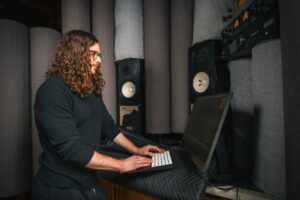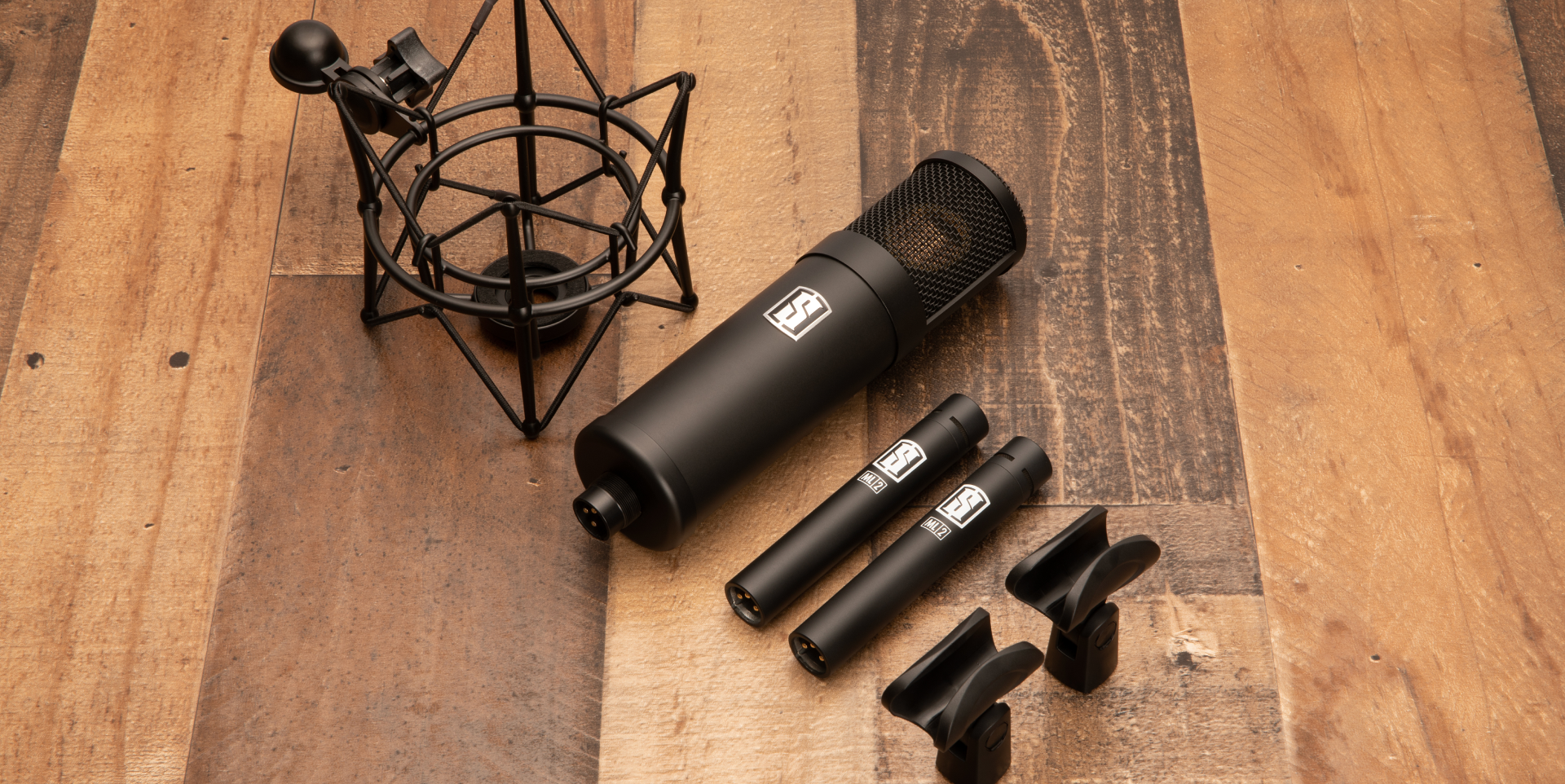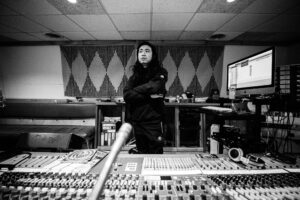
Armed with a killer ear and a love for all things music, JESSE RAY ERNSTER’s journey began in the heart of Minnesota. Born into a musical family, the Grammy winner started honing his craft early, starting in local studios before branching into his own engineering exploits.
Since then, he has exploded onto the scene, working with everyone from indie darlings to chart-topping pop sensations, securing several platinum records and major accolades in the process. Overflowing with Midwest charm and even more talent, Jesse Ray Ernster has quickly established himself as a go-to guru for shaping your songs to perfection.
SLATE DIGITAL: Okay, first things first. For those who don’t know: who is Jesse Ray?
JESSE RAY ERNSTER: Well, I am a 32-year-old musician, record mixer, music lover, and California outdoors enthusiast. I come from the cold Midwest. I was born in Canada but raised primarily in Minnesota. My folks were musical, so this was the world that I came up in. It’s been a lifetime of music and working on the craft. It’s what I obsess about. It’s the only thing I can think about and the only thing I want to be doing at any point throughout the day, on any given day.
SD: I was reading an interview that you did where you talked about renting a cabin straight out of high school that you used to record your friends and bring people in, and that the vibe in that space was just really kind of unique. Can you talk a little bit more about that process and that whole experience?
JRE: I would love to! Nobody ever asks about that.
I called it Echo Cabin. It was a 900-square-foot one-story cabin with two bedrooms and a basement that had a laundry room and a brick garage. The upstairs was an all-pine interior, so the walls and the ceiling were pine and then the floors were made of oak and this was part of the deal that I would get to move in and rent.
My buddy was the landlord. I told him I’d rip out all the old rotten carpet and refinish the flooring. I wanted to turn it into a vibey recording house, so I did all that work in exchange for a good deal on rent, specifically $400.00 a month on this unbelievable lakefront property. Right out the window was Buffalo Lake. I could walk out the back door down the steps and I’d be right at the water. It was amazing.
The view of the lake from Echo Cabin.
It was such a valuable experience. I was terrible at making records; this was literally my first place after I left my dad’s studio. I’d been getting my feet wet on his antiquated Pro Tools set up, so I was eager to rebel against that and do everything the opposite way.
I got different monitors, my trusty NS10’s. I used a different DAW and pivoted to Logic Pro 9. I was trying to forge my own path and figure it out. I had a drum kit in there that was mic’d up at all times, some guitar amps, a vocal mic and a little vocal booth I’d set up. I also had mics down the stairwell to pick up the ambience of the space.
That place was incredible, because it‘s where I got to learn how to engineer. I was working with a lot of country bands and some rock bands, and even a lot of college acapella projects. That was a gig I got pretty good at, so I kept getting calls.
SD: What are the core differences between an acapella mix session and a Burna Boy mix session? Are there any significant adjustments you need to make between the two?
JRE: You’d be surprised how similar they are! But one thing that was so specific about those sessions was this: let’s say you have 12 people in the acapella group, and we’re usually quad-tracking every single part. That’s about 50 vocal tracks just to make up the body of the core supporting vocal. Then there’s always a lead in the middle, and then there’s the percussive tracks, just so many stacks of vocals.
When I attacked those stacks with compression, even applying just a DB of gain reduction, I found that it was a nightmare for noise and hiss. At first, I thought it was just the room we were recording in or the way we were recording. But when we eventually ended up going to a professional room that had a proper vocal setup, we ran into the same issue. That taught me early on that compression isn’t going to achieve the vocal leveling effect I’m looking for. I have to go through and level those vocals out with manual automation and ignore compressors. They can quickly do more harm than good.
SD: You strike me as a person who is very appreciative of history. The history of music in Minneapolis and across Minnesota is so rich and deep, it feels like it gets lost in comparison to the more widely renowned histories of Detroit or Memphis. What was it like for you as a developing musician growing up in that environment?
JRE: Well, obviously, that song “Funky Town” was written about Minneapolis. When you think about the history of funk and the role Prince played, it was all really influential. My favorite way to connect with that history was to go down to Bunker’s [Music Bar & Grill] on a Sunday or Monday night and listen to the house band Doctor Mambo’s Combo, which was Michael Bland and Sonny T, just the most unbelievable group of musicians that would play. It was really inspiring.
More recently, another Minneapolis guy Cory Wong has gone on to completely dominate the universe. And another dude, Jeff Braun, this great country mixer who does, like, everything now. He grew up like 15 minutes from where I grew up. We both grew up doing this and being interested in music, but it took until we both ended up living in Nashville for us to finally be like ‘Hey, we’re from the same city!’
SD: Something else I learned that stood out to me while I was prepping for our conversation was that you’ve ditched the traditional mixing desk for a more on-the-go sort of workflow. Is that still the case?
JRE: Yep. I went through a phase of needing to have a spaceship desk and needing to validate my worth as an engineer in the form of having a rack full of gear and equipment, which is funny because now, I don’t think that there’s a correlation there at all. And frankly, when I got rid of the spaceship desk and all the stuff that was sitting between me and the speakers, it ended up sorting out the acoustics and alleviating a lot of the sonic issues I’d been struggling with forever.

Jesse Ray working in his custom mixing studio environment, surrounded by his trusty NS10 monitors.
I think it’s really empowering to promote using limited gear or budget gear to get pro results. That’s the main message I want to send to anyone doing this: you can do this without breaking the bank or putting yourself into an uncomfortable financial position. I’m speaking from experience because I do not come from a place of financial prosperity. I had to save up every single penny to buy the things that I have.
You can do the job with some NS10s and mixing in the box with great plugins. Just keep it simple and worry about getting the room right, getting the right monitors, etc.
SD: How did the Burna Boy connection come about?
JRE: We were connected through my manager right around the time that my manager Matthew signed Burna to Atlantic. I reached out to him and his team and said, ’Hey, I would love to meet with you and talk about you and your company Bad Habit managing me.’ We got together, and they were like, ’Yep, this seems like a great fit. Now let’s see if you can execute.’ The very first thing that they put me on was the first Burna Boy EP that we did and that went great.
So then right after that, they put me on the full album project, which was the “African Giant” album, which was the very first full-length label album I had ever mixed. I’m very grateful to have worked on this album that became significant for the culture and has become a widely celebrated record in many parts of the world.
SD: What does your workflow with Burna look like these days?
JRE: He has an engineer, Otis, who does all the recording and takes care of all the sessions. Then when it’s ready for mix, they send me that stuff and then I mix it. I’ve never recorded Burna, I’ve only ever been the mixer, but there was a stage between “African Giant” and “Twice as Tall” where they didn’t even have a recording engineer. Somebody would record him, and they would send me blank vocals.
We built the whole “Twice as Tall” album over the pandemic over Zoom over Audiomovers. Burna was over there, I was over here, and we built the sounds for every single song, trying new things and getting creative. We got to produce his vocal sound from the ground up on that album, so the fact that it won a Grammy is awesome.
I think that the way you achieve [a] Zen state over time is by repeatedly facing that fear and learning, ‘I’m OK, I’m safe.’ …You just keep going. You just gotta focus on the things that matter.
SD: With an artist like Burna or Doja for example, or any project with major label expectations attached, do you feel any added pressure when you’re working on a major label project, or do you feel the same pressure regardless of the, for lack of a better word, ‘stature’ of the artist?
JRE: Really good question. Early on I would get very psyched out when the stakes were high. If it were label or a big artist, or there was a big opportunity or a spec mix like a test mix to try out, you know I would get psyched out and I would overthink it, and the results are almost always worse in that situation.
I’ve gotten to a point now where I’m really getting comfortable with my monitoring and with my workflow and I think I’m starting to get results that I’m pleased with. So now when I get a project, whether it’s big or small, I’m generally just diving in and tackling the problems and approaching it and just trying to have a really good time doing it.
Ultimately, if I can keep my equilibrium and keep overall pressures low, then things go well: when I don’t overthink it, I can just have a good time. It’s almost like the fear of messing up an opportunity can influence me to head in the wrong direction.
SD: How do you achieve that calm and stay focused on the moment?
JRE: I think that the way you achieve that Zen state over time is by repeatedly facing that fear and learning, ‘I’m OK, I’m safe.’ And it’s true. I’m not running through the jungle being hunted or fighting for my life; I am just working on music. That’s all it is. And the worst of the worst of the worst consequence is that maybe you’re not the right fit for the gig and you don’t get the gig. And like, yes, that would be terrible. But guess what: I have lost so many gigs.
I talk about this a lot. I’ve lost huge gigs that could have put me on a better path than I’m on. And that could be really upsetting, but it’s just not my style to dwell on those alternate timelines or those potentials. You just have to focus on the things that you can change, and remember that there’s always gonna be opportunities. There’s always more. You just keep going. You just gotta focus on the things that matter.
SD: So since this is a Slate Digital interview, I have to ask: are there any SD standbys that have existed in your workflow?
JRE: Yeah! I have Transient Shaper in my template. I’m using that on drums, but also as a de-esser on vocals as well. And a new favorite of mine has been Heatwave. It’s just beautiful.
SD: Can you talk a little bit about your Transient Shaper de-essing technique? I don’t know that anybody’s ever talked about using it that way.
JRE: So I’ll use the Focus feature to target the upper quadrants of the frequency range. I’ll listen for those transients that cut through and turn them down, and sometimes I’ll turn the warmth up to add some extra overtones and density to T’s.
I’ll also sometimes pick the exact same focus range in the Sustain section and turn that dial down too. A lot of the time with ‘S’ sounds, the issue is that they get sloshy. Being able to focus on where the sibilance is and turn both the transient and sustain down produces an effect that really helps.
SD: Is there anybody you haven’t gotten to work with yet that you’d like to do some more stuff with?
JRE: Oh yeah, 100%. I really want to work and collaborate with Stewart Copeland on something. Even if it’s just like a session, like getting him to track on something, or maybe we make some piece of software together, I don’t know. I just really, really want to connect with Stewart Copeland.
As far as more modern pop-leaning stuff, there’s Dua Lipa, but that’s my buddy Gudwin’s gig. Or Ice Spice! But that’s my buddy Teezio’s gig.
SD: He’s having a real moment right now, isn’t he? Teezio’s been getting a lot of attention.
JRE: Can you put this in the interview? He has worked for this. He has earned it. He deserves it.
SD: It’s in.
JRE: Teezy goes crazy.
SD: I guess we can leave off with your standard end-of-interview question: What’s next on your calendar? Anything cool we preview or highlight?
JRE: Yeah, I just worked on the mix for a new G-Eazy record called “Femme Fatale” that’s pretty rad. Otherwise, I’m just going to keep my head down, keep making music, and try to stay out of trouble this year. You folks do the same.
SD: Thank you, Jesse! We will.
—
Listen to Jesse Ray Ernster’s work below:















 The
The 


 Since the goal is to put these individual life timestamps to tape, is there any part of the process that manages to translate pretty similarly from artist to artist? Or is it an inherently unique experience every time?
Since the goal is to put these individual life timestamps to tape, is there any part of the process that manages to translate pretty similarly from artist to artist? Or is it an inherently unique experience every time?

